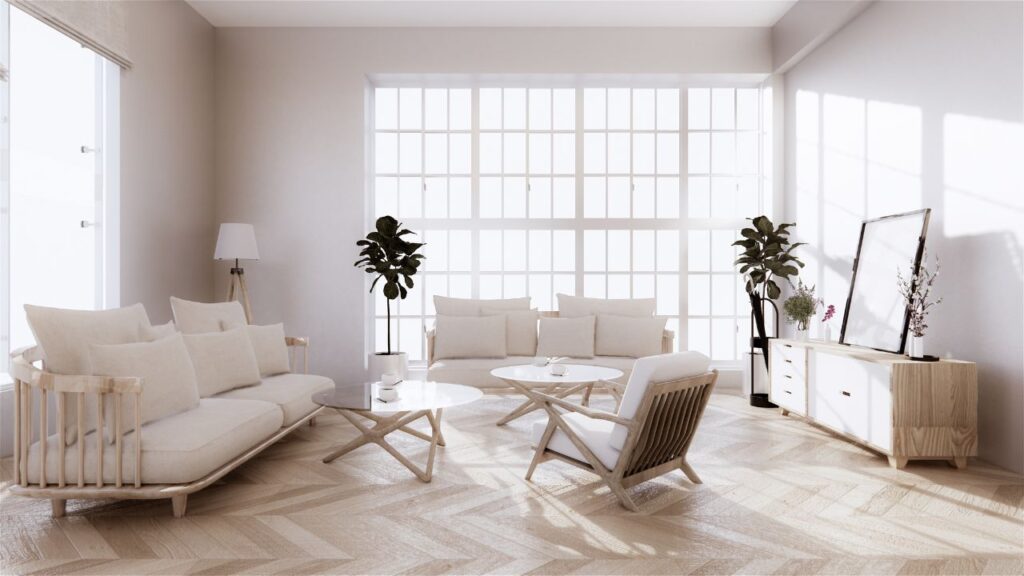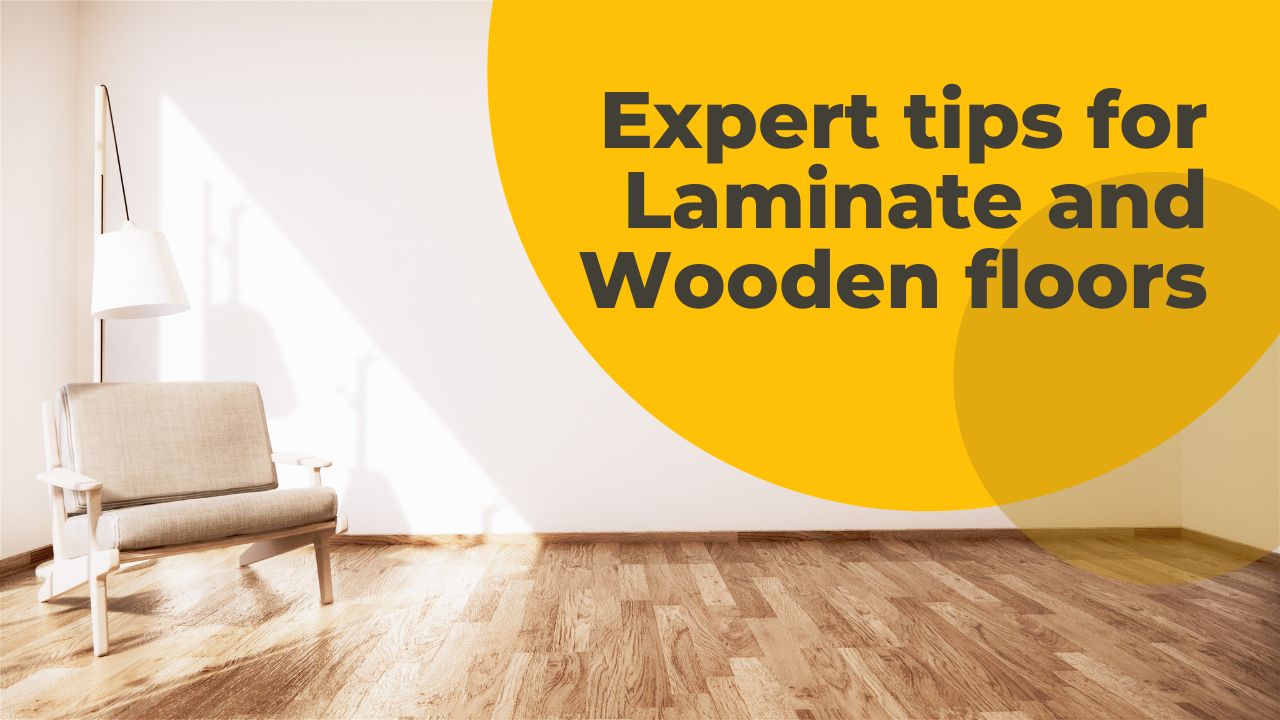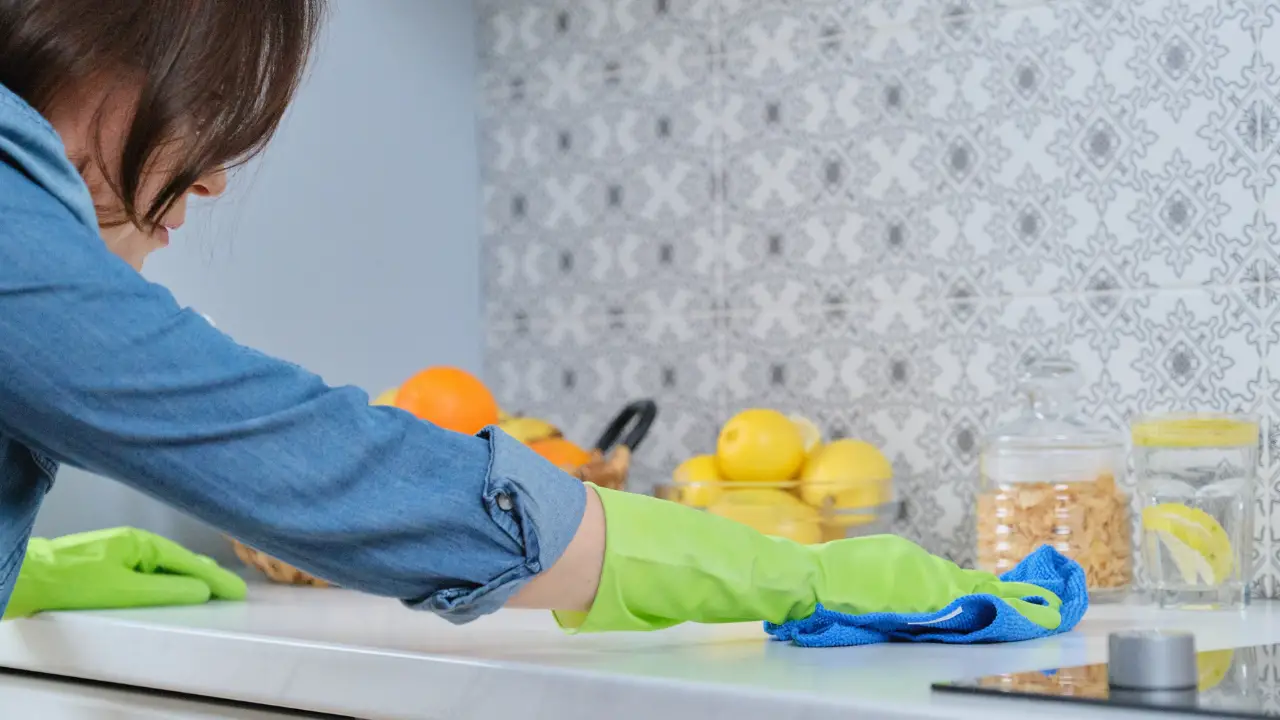A beautiful laminate or hardwood adds style to a room, but it’s also important to keep it clean. Learn our tips below for cleaning these types of floors.
Whats in this article?
General maintenance tips
Proper care is key to keeping your laminate or wooden floor looking clean and well-maintained. I’m sharing some tips that you can follow to help keep your floor in great condition. From regular vacuuming and sweeping to using protective mats and wiping up spills, these tips will help you keep your floor looking its best with minimal effort.
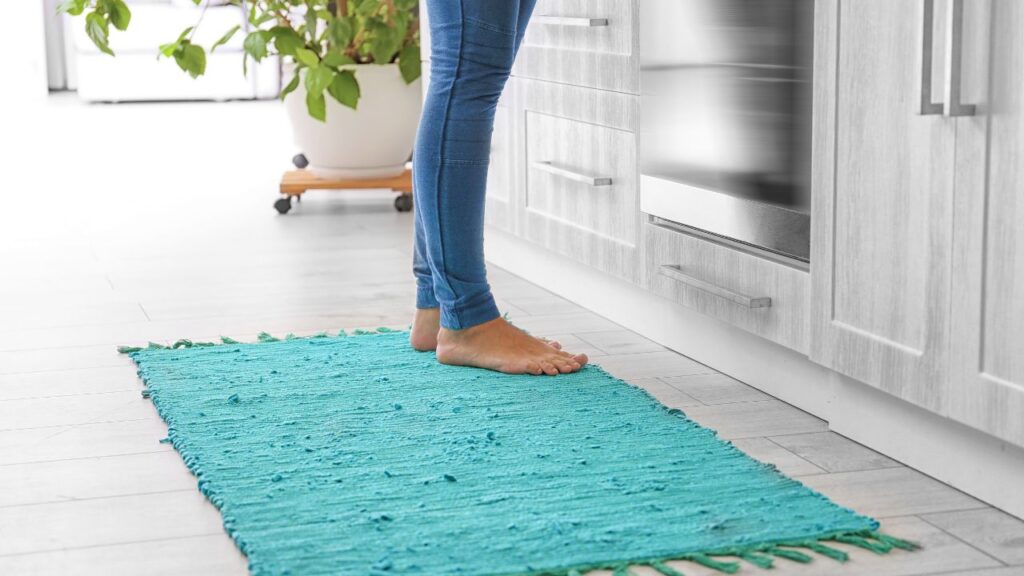
- Vacuum or sweep regularly to remove dirt, dust, and debris, this prevents dirt getting trodden in.
- Use doormats or rugs at entryways to reduce the amount of dirt and grit that gets tracked onto the floor. We have a handy guide on cleaning doormats here.
- Remove shoes before walking on the floor, especially if you have been outside or if you have dirty shoes. Removing shoes will also prevent scuff marks on your floors – we have a guide on how to remove scuff marks here should this happen.
- Protect the floor from furniture legs and other heavy objects by using felt pads or protective mats
- Avoiding using excess water or standing water when cleaning, as this can damage the floor or cause it to expand and warp.
- Wiping up spills as soon as they occur will help prevent staining or damage.
Cleaning up spills and stains
Accidents happen, and it’s important to know how to clean up spills and stains on your laminate or wooden floor as quickly and effectively as possible.
Here, I will provide tips and techniques for removing a variety of common spills and stains, including food, drink, and household messes. By following these guidelines, you can help prevent lasting damage and keep your floor looking clean and beautiful.
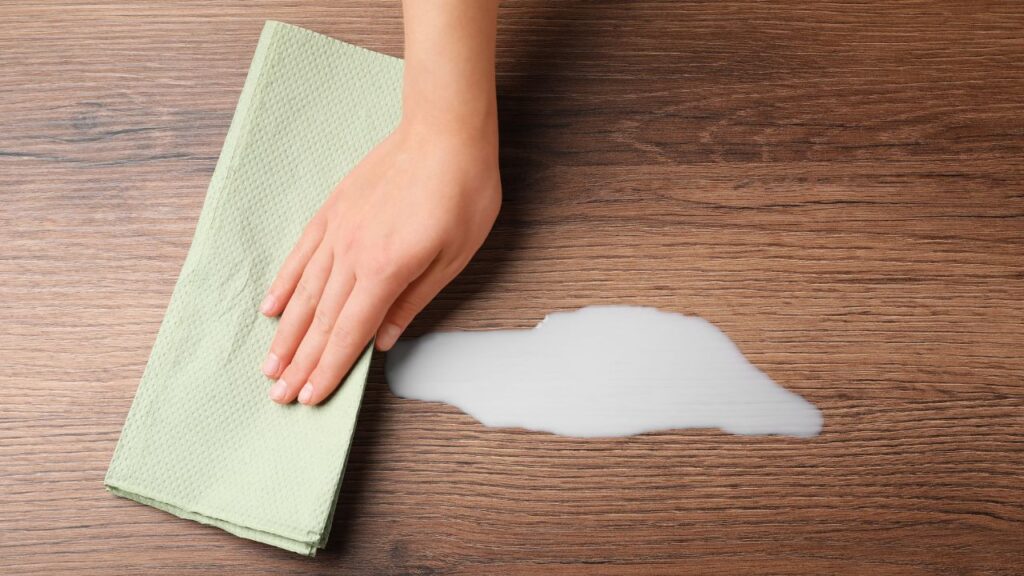
- Act fast: The quicker you can clean up a spill, the less likely it is to cause a permanent stain. Have a supply of clean, absorbent cloths or paper towels on hand to blot up spills as soon as they occur.
- Blot, don’t rub: When cleaning up a spill, use a blotting motion to absorb the liquid rather than a scrubbing motion. Rubbing can spread the spill or cause damage to the floor surface.
- Use the right cleaner: Different types of spills and stains may require different cleaning solutions. Water and mild soap are generally safe to use on most laminate and wooden floors, but you may need to use a specialty cleaner for tough stains or for certain types of flooring.
- Test a small area first: Before applying any cleaning solution to a large area, test it in a small, inconspicuous spot to make sure it doesn’t damage the floor.
- Be gentle: Use a soft cloth or sponge to clean the floor, and avoid using abrasive tools or harsh chemicals that could scratch or damage the surface.
Dealing with scratches and damage
Despite your best efforts to keep your laminate or wooden floor looking clean and well-maintained, scratches and damage may occur from time to time. In this section, I’ll provide tips and techniques for repairing and camouflaging scratches and other types of damage on your floor. Whether you’re dealing with small nicks and scratches or more serious damage, these tips will help you keep your floor looking its best.
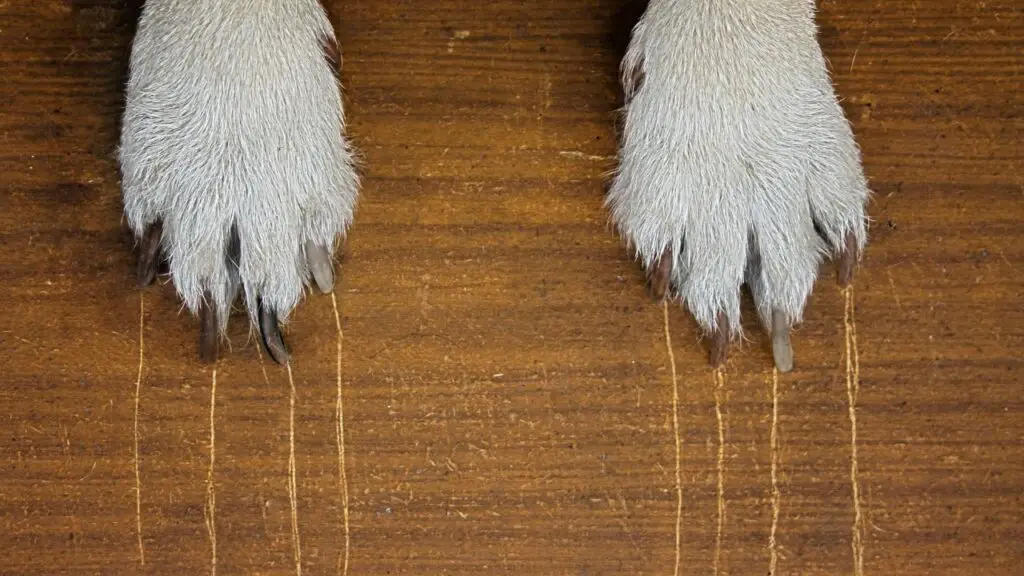
- Repair or replace damaged boards: If you have a deep scratch or a severely damaged board, it may be necessary to repair or replace it. This can usually be done by a professional flooring contractor or by following the manufacturer’s recommendations. (When laying a new floor, its usually a great idea to keep an extra pack of flooring back for such occurrences).
- Use a touch-up kit: If you have a small scratch or blemish on your floor, a touch-up kit can help to camouflage it. These kits are usually available from the manufacturer or a flooring retailer and often include a matching wood filler and a finish to match the color of your floor.
- Use a wood-colored crayon: For small scratches, you can try using a wood-colored crayon to fill in the scratch and blend it in with the surrounding floor. This can be a quick and easy way to disguise minor scratches.
- Apply a wood-colored wax stick: Similar to a wood-colored crayon, a wood-colored wax stick can be used to fill in scratches and blend them in with the surrounding floor. Simply rub the stick over the scratch and wipe away any excess wax with a clean cloth.
- Cover the damage with a rug or mat: If the damage is extensive or you are unable to repair it, you may want to consider covering it up with a rug or mat. This can help to protect the floor from further damage and add a decorative touch to the room.
Using natural or chemical cleaners
When it comes to cleaning your laminate or wooden floor, you have a choice between using natural or chemical cleaners.
Natural cleaners are usually made from plant-based ingredients and are generally safer and more eco-friendly than chemical cleaners. However, they may not be as effective at removing tough stains or heavy grime.
Chemical cleaners, on the other hand, are more effective at removing dirt and stains, but they may contain harsh chemicals that can be harmful to people, pets, and the environment.
In this section, we will provide tips and guidance for choosing the right cleaner for your laminate or wooden floor and using it safely and effectively.
- Use a mild cleaner: For most routine cleaning, a mild cleaner is usually sufficient. Look for a cleaner that is specifically formulated for use on laminate or wood floors, or use a mild, pH-neutral soap such as dish soap.
- Avoid using excess water: Too much water can damage laminate and wood floors, so it’s important to use a damp rather than a wet mop or cloth when cleaning. Be sure to wring out your mop or cloth well to remove excess water.
- Choose a natural cleaner for regular cleaning: For regular, routine cleaning, a natural cleaner is the safest choice. There are many natural cleaners on the market that are specifically formulated for use on laminate and wood floors. You can also make your own natural cleaner using ingredients like vinegar, baking soda, or essential oils.
- Use a chemical cleaner only tough stains: For tough stains or heavy grime, a chemical cleaner may be necessary. Look for a cleaner that is specifically formulated for use on laminate or wood floors and follow the manufacturer’s instructions carefully.
- Be mindful of the environment: If you choose to use a chemical cleaner, be sure to dispose of it properly and follow all safety precautions to minimize the impact on the environment. If you prefer a more eco-friendly option, consider using a natural cleaner or making your own using ingredients like vinegar and baking soda.
Deep cleaning techniques
While regular maintenance is important for keeping your laminate or wooden floor looking clean and well-maintained, it’s also important to give it a thorough deep cleaning from time to time. Deep cleaning involves removing built-up dirt, grime, and stains that regular cleaning may not remove. In this section, I’ll provide tips and techniques for giving your floor a deep clean, including the use of specialized equipment and products. By following these guidelines, you can help restore the natural beauty of your floor and keep it looking its best.
- Use a specialty cleaner: For a thorough deep clean, consider using a specialty cleaner that is specifically formulated for laminate or wood floors. These cleaners are designed to penetrate deep into the pores of the floor and remove built-up dirt, grime, and stains.
- Use a floor cleaner machine: A floor cleaner machine can make deep cleaning your laminate or wooden floor easier and more effective. These machines are available in a variety of styles, including steam mops, hardwood floor cleaners, and scrubber-dryers. Choose a machine that is appropriate for your flooring type and follow the manufacturer’s instructions carefully.
- Use a wood floor cleaner: If you have a wood floor, you may want to use a wood floor cleaner specifically designed for this type of flooring. These cleaners are usually more gentle than other types of cleaners and are formulated to protect and enhance the natural beauty of the wood.
- Use a soft-bristled brush: For tough stains or heavy grime, a soft-bristled brush can be used to scrub the floor gently. Be sure to use a circular motion and avoid using too much pressure, as this can damage the floor.
- Rinse and dry the floor: After deep cleaning, be sure to rinse the floor with clean water and dry it thoroughly. This will help remove any residue and prevent the floor from becoming slippery.
Preventing future damage
While it’s important to know how to clean and repair damage on your laminate or wooden floor, it’s even better to prevent damage from occurring in the first place.
In this section, I’ll give you some tips and techniques for protecting your floor from future damage, including the use of protective mats, avoiding certain cleaning products and practices, and taking care when moving heavy objects on the floor. By following these guidelines, you can help keep your floor looking clean and beautiful for years to come.
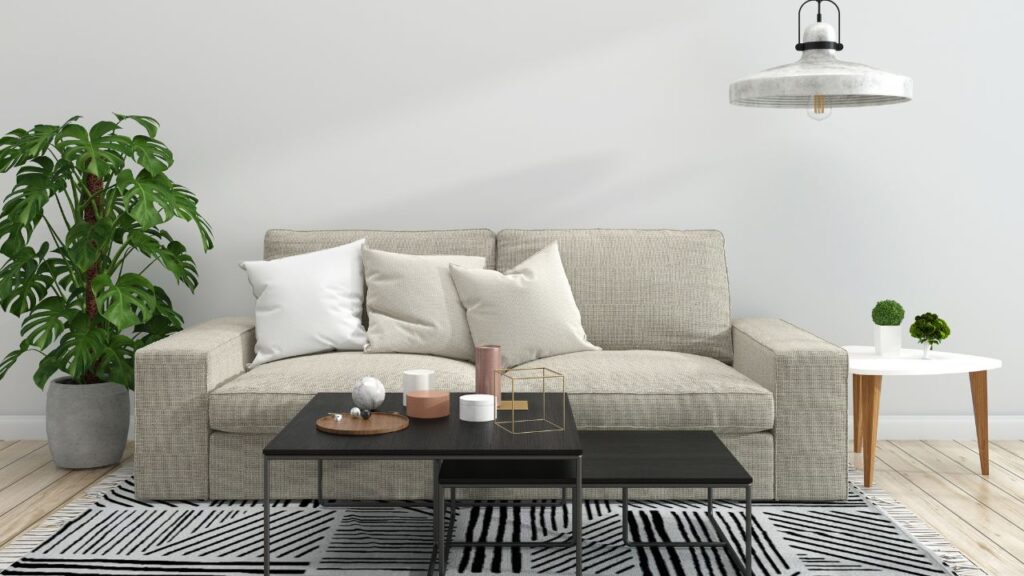
- Use protective mats: Placing mats at entryways and in high-traffic areas can help reduce the amount of dirt and grit that gets tracked onto your floor. This can help prevent scratching and other types of damage.
- Avoid using harsh chemicals: Some cleaning products and practices can be harsh on laminate and wooden floors. Avoid using abrasive tools or harsh chemicals that could damage the surface of the floor.
- Use furniture pads: Protect your floor from scratches and dents caused by furniture legs by using furniture pads or felt pads on the bottoms of your chairs, tables, and other heavy objects.
- Avoid dragging heavy objects across the floor: When moving heavy objects on your floor, lift them rather than dragging them to prevent scratches and dents.
- Follow the manufacturer’s recommendations: The manufacturer of your laminate or wooden floor will have specific recommendations for how to care for and maintain the floor. Be sure to follow these recommendations to help prevent damage.
Conclusion and final thoughts 💭
Laminate and wooden floors are an attractive and durable addition to any home, but they do require some care and maintenance to keep them looking their best. By following expert tips and techniques for general maintenance, cleaning up spills and stains, dealing with scratches and damage, choosing the right cleaner, and deep cleaning, you can keep your floor looking clean and beautiful for years to come.
With a little bit of effort and attention, you can maintain the natural beauty of your laminate or wooden floor and enjoy it for years to come.
